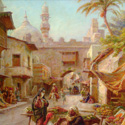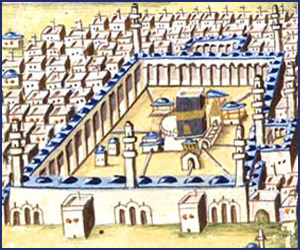Cities of Islam

|
When during the crusades
(1095-1291), the Western Christians came in contact with the
Muslim East, Erbstosser says, the size and structure of Muslim
cities must have been impressive for such crusaders.[1]
At the beginning of the 11th century,
It
was, thus, a new and alien world with advanced economic and
cultural standards, that confronted the crusaders.[7]
Indeed, the contrast between East and West as far as
urbanisation goes could not be sharper. In medieval times,
whilst Western Christendom was formed of a society primarily
agrarian, feudal, and monastic, the strength of Islam was in its
great cities, wealthy courts, and long lines of communication.[8]
In Europe, the cities of antiquity had disappeared due to
economic crises, (5th century) invasions and
brigandage; the town was now merely a cramped castrum for
defence and refuge; the period was marked by the triumph of the
large estate and of rural economy ‘Barbarisation and
ruralisation having spread over almost the whole of the Western
World,’ says Lombard.[9]
Which contrasts sharply with Islamic Cordova, a city of
fountains; baths, schools, and much else, its thoroughfares, for
a distance of miles, brilliantly illuminated, substantially
paved, kept in excellent repair, regularly patrolled by
guardians of the peace.[10]
In Paris there were no pavements until the 13th
century; in London none until the 14th; the streets
of both capitals were often impassable, and it was only at the
close of the reign of Charles II (17th century), that
even a defective system of street lighting was adopted in
London.[11]
And the contrast was even greater, when considering that a city
such as Baghdad
at the end of the 9th
century had a population exceeding one million people, whilst
even in the 13th century, Lombard insists, we are
struck by the difference with Western Christendom; cities in
Italy, or Flanders, with population not exceeding thirty or
forty thousand people.[12]
In 1700,
It
is not just this contrast which is startling, especially when
one considers today’s situation, it is more astounding that the
early environment of Islam was the sands and tents of
[1]
M. Erbstosser: The Crusades (David and Charles;
Newton Abbot; Leipzig; 1978), pp. 130-1.
[2]
Ibid.
[3]
Ibid.
[4]
Ibid.
[5]
Ibid.
[6]
Z. Oldenbourg: The Crusades; tr from the French
by A. Carter (Weinfeld and Nicolson; London; 1965), pp.
476; 498.
[7]
M. Erbstosser: The Crusades; op cit; pp. 130-1.
[8]
R.W. Southern: Western Views of Islam in the Middle
Ages (Harvard University Press, 1978), p. 7.
[9]
M. Lombard: The Golden; op cit; p. 119.
[10]
S.P. Scott: History; Vol 3; op cit; pp 520-2.
[11]
Ibid.
[12]
M. Lombard: l’Evolution Urbaine; pendant le Haut Moyen
Age; in Annales, vol 2 (1957) pp. 7-28; p. 24.
[13]
S.P. Scott: History; op cit; pp 520-2.
[14]
M. Lombard: l’Evolution Urbaine;
op cit; p. 24.
|





